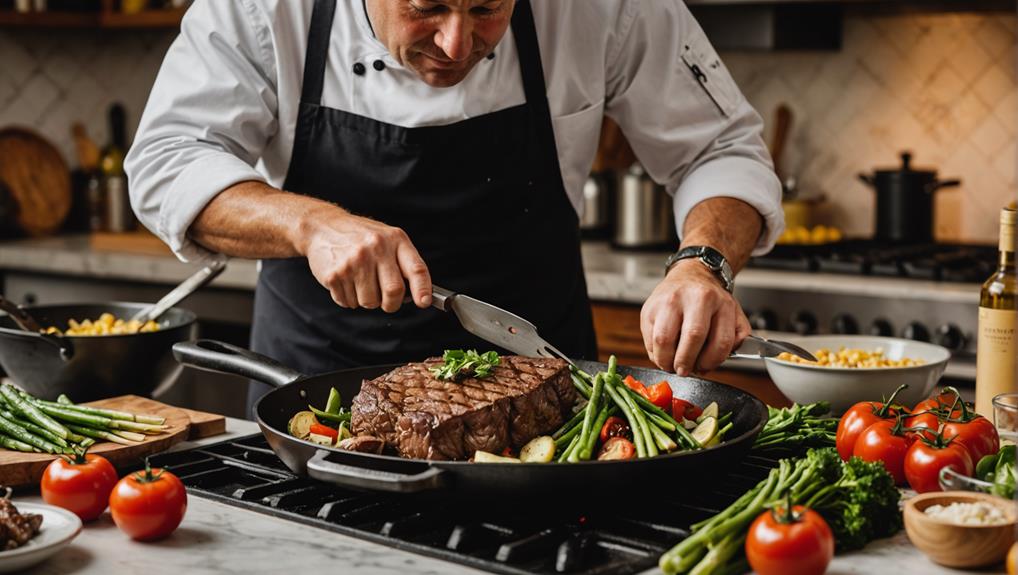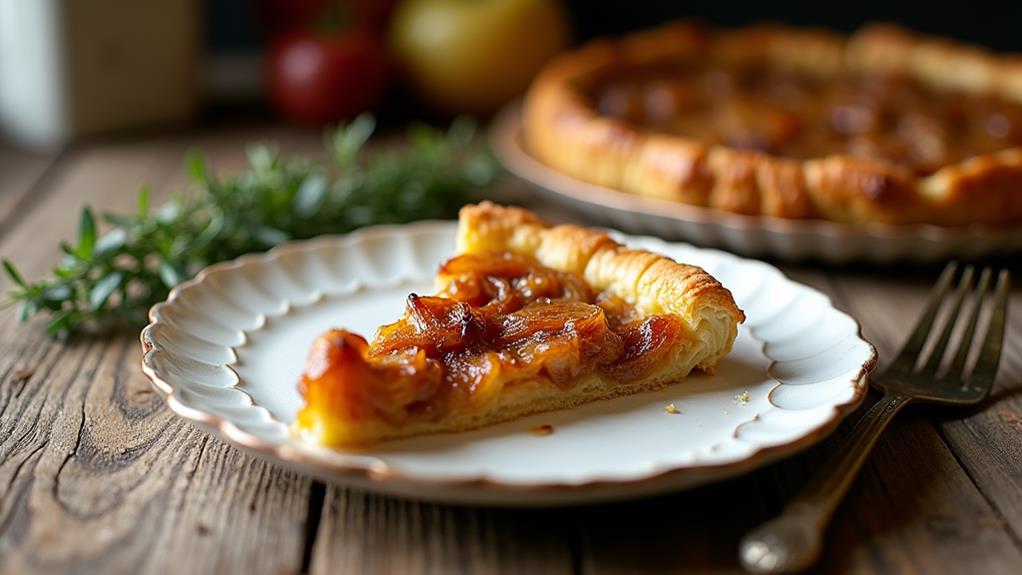To achieve restaurant-quality meals at home, master sous vide cooking. This precision technique involves sealing food in vacuum bags and cooking it in a temperature-controlled water bath. You'll need an immersion circulator, vacuum-sealed bags, and a large pot or container. Control temperature and timing meticulously for perfect doneness every time. Prioritize food safety by following proper guidelines. Season ingredients thoughtfully, and finish dishes with searing or other techniques for optimal texture and flavor. Plate your creations with care, using contrasting colors and textures. By understanding these fundamentals, you'll elevate your home cooking to professional standards. Discover how to transform your kitchen into a gourmet haven.
Understanding Sous Vide Cooking Basics
Precision is the hallmark of sous vide cooking, a technique that's revolutionizing home kitchens. If you're looking to elevate your home cooking to restaurant-quality meals, mastering sous vide is your ticket to culinary excellence.
This innovative method involves sealing food in a vacuum bag and immersing it in a temperature-controlled water bath. The result? Perfectly cooked dishes with unparalleled consistency.
You'll find that sous vide cooking offers unmatched control over doneness, especially for proteins. By setting the exact temperature you desire, you'll never have to worry about overcooking again. This precision not only enhances tenderness but also locks in flavors that might otherwise be lost.
For busy home cooks, sous vide is a game-changer. You can leave meats cooking for hours without sacrificing quality, freeing up your time for other tasks.
Another advantage is the intensified flavor infusion. Marinades and seasonings penetrate more deeply, resulting in more flavorful dishes.
While sous vide requires specialized equipment like immersion circulators, affordable options are now available for home cooks eager to experiment with this method.
Essential Equipment for Sous Vide
To achieve restaurant-quality sous vide cooking at home, you'll need equipment that ensures precise temperature control and essential accessories.
Your primary investment should be a reliable sous vide immersion circulator, which maintains water at a consistent temperature throughout the cooking process.
Additionally, you'll want to acquire vacuum-sealed bags, a digital thermometer, and an insulated container or water bath to complete your sous vide setup and maximize your culinary results.
Precision Temperature Control Equipment
At the heart of sous vide cooking lies precision temperature control equipment, essential for achieving restaurant-quality results at home. Immersion circulators are the cornerstone of this method, maintaining water temperatures within 0.1°C accuracy. This level of precision ensures your food cooks evenly and retains moisture, allowing you to achieve perfect doneness without the risk of overcooking.
To elevate your sous vide game, consider investing in high-quality containers and vacuum-sealed bags. These minimize water displacement and promote even heat distribution, crucial for consistent cooking results.
Many modern sous vide machines come with app connectivity, enabling you to monitor and adjust cooking times and temperatures remotely. This feature adds convenience and precision to your culinary endeavors.
For the ultimate in accuracy, a digital sous vide thermometer is a worthwhile addition to your kitchen arsenal. It provides real-time temperature readings, ensuring food safety and optimal cooking conditions.
Essential Sous Vide Accessories
Equipping your kitchen with essential sous vide accessories is crucial for achieving restaurant-quality results at home. To elevate your sous vide cooking experience, you'll need a precision immersion circulator, vacuum-sealed bags or silicone pouches, a digital thermometer, and a water bath container. These tools work together to ensure precise temperature control and even cooking throughout the process.
Your sous vide setup should include:
- A large pot or dedicated sous vide container
- Vacuum-sealed bags or reusable silicone pouches
- Sous vide weights or clips
- A digital thermometer for double-checking internal temperatures
The precision immersion circulator is the heart of your sous vide system, maintaining water temperature within 0.1°F for consistent results. Vacuum-sealed bags or silicone pouches prevent water from entering your food while facilitating proper heat transfer.
A digital thermometer helps verify food safety and optimal doneness before serving. The water bath container, whether a large pot or specialized sous vide container, keeps water levels stable and promotes even heating.
Temperature Control and Timing
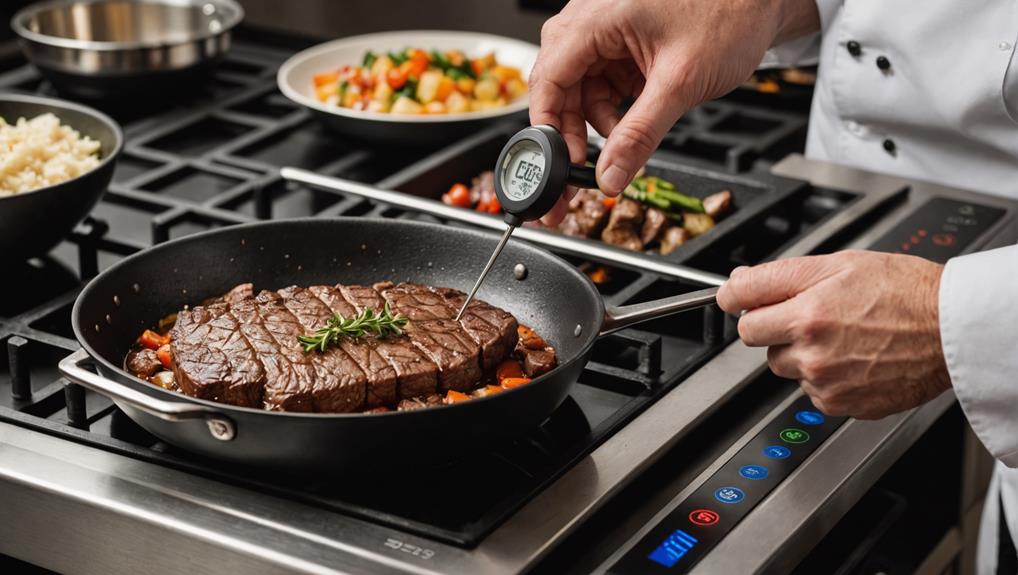
To achieve restaurant-quality meals at home, you'll need to master precise cooking temperatures and timing.
For hearty dishes like Slow Cooker Chili Con Carne, using an instant-read thermometer ensures your meats reach the ideal internal temperature, such as 145°F for pork and 165°F for poultry, guaranteeing both safety and optimal flavor.
Precise Cooking Temperatures
Mastering precise cooking temperatures is the key to elevating your home-cooked meals to restaurant quality. By understanding and controlling heat, you'll unlock the secret to perfectly cooked dishes every time.
Precise temperature control ensures that your proteins reach their optimal internal temperature, resulting in safe, flavorful, and restaurant-quality textures. For instance, preparing a rich Mushroom Risotto With Thyme highlights the importance of temperature when toasting Arborio rice and gradually adding warm broth for a creamy consistency. Use an instant-read thermometer to monitor your food's internal temperature, aiming for specific targets like 165°F (75°C) for chicken.
For even more control, consider sous-vide cooking. This method maintains exact temperatures, allowing proteins to cook evenly and retain moisture. When searing meats, aim for temperatures between 300°F and 500°F (150°C to 260°C) to achieve the flavorful Maillard reaction.
Remember, timing is crucial, especially for delicate items like fish. Aim for 145°F (63°C) to ensure a moist outcome.
To achieve restaurant-level precision in your cooking:
- Invest in a reliable instant-read thermometer
- Experiment with sous-vide cooking for consistent results
- Master the art of searing at high temperatures
- Maintain consistent oven or stovetop temperatures within 5°F (3°C) of your target
Mastering Cooking Times
The secret to restaurant-quality meals lies in mastering cooking times through precise temperature control and timing. Attention to detail is crucial when elevating your home-cooked meals to professional standards. Start by investing in an instant-read thermometer to ensure your meats reach the perfect internal temperature. For pork, aim for 145°F, while poultry requires 165°F. This precision prevents overcooking and guarantees food safety.
To complement your precision, consider incorporating hearty dishes like chicken pot pie into your meal planning, where timing is essential for achieving a golden brown crust.
Master the art of cooking vegetables by understanding their optimal cooking times. Blanch green beans for 3-5 minutes to maintain their vibrant color and crisp texture. For proteins, consider sous-vide techniques, which allow for precise temperature control and even cooking. A medium-rare steak can be achieved at temperatures as low as 130°F.
Don't overlook carryover cooking when mastering cooking times. Let roasts rest for 15-30 minutes after removing them from heat to achieve optimal tenderness.
Utilize timers to track cooking durations accurately, such as setting a 20-minute alarm for baking cakes. By focusing on these details and implementing precise timing strategies, you'll transform your home kitchen into a culinary powerhouse, consistently producing restaurant-quality meals.
Food Safety in Sous Vide
When it comes to sous vide cooking, food safety is paramount. To ensure your culinary creations are as safe as they're delicious, follow these key guidelines.
First, maintain precise temperature control throughout the cooking process. Keep water temperatures below 140°F (60°C) for meats, and cook for appropriate times to eliminate bacterial risks.
Second, use a reliable food thermometer to verify that your dish's center has reached the recommended safe temperature for its protein type.
For optimal food safety in sous vide:
- Properly seal bags to prevent water contact and cross-contamination
- Rapidly chill cooked items to below 40°F (4°C) within two hours if not consuming immediately
- Use fresh, high-quality ingredients to minimize initial bacterial presence
- Clean and sanitize all equipment thoroughly before and after use
Seasoning for Maximum Flavor
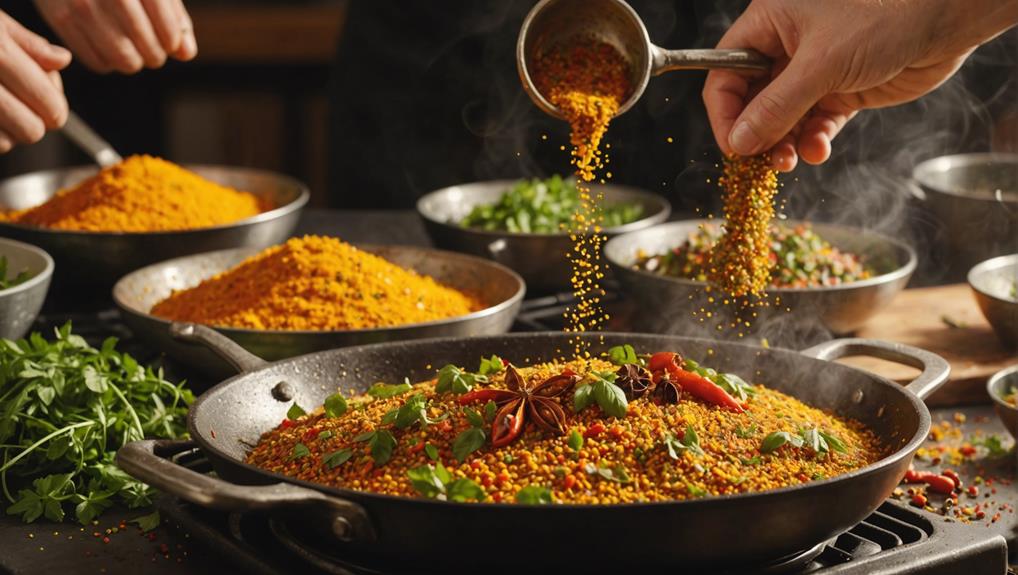
Seasoning is the key to transforming ordinary ingredients into extraordinary meals. To achieve restaurant-quality flavor profiles at home, you'll need to master the art of seasoning throughout the cooking process. Start by tasting as you go, adjusting salt levels to enhance sweetness and suppress bitterness. This approach will help you build depth in your dishes, creating a more complex taste experience.
Don't underestimate the power of acidity in your culinary creations. A splash of lemon juice or vinegar can brighten flavors and elevate the overall taste of your dish.
When it comes to spices, layer them throughout the cooking process rather than adding them all at once. This technique allows for a more nuanced development of flavors, mimicking the complexity found in professional kitchens.
Fresh herbs should be your go-to for adding vibrant flavors and aromas. Prioritize these over dried alternatives to significantly enhance your dishes.
Perfecting Texture With Sous Vide
While seasoning is fundamental to flavor, achieving the perfect texture is equally important for restaurant-quality meals. Enter sous vide, a cooking technique that's revolutionizing home kitchens. This method ensures your proteins and vegetables are cooked to perfection, every time. By vacuum-sealing ingredients and cooking them in a precisely controlled water bath, you'll unlock a world of culinary possibilities.
Sous vide cooking offers several advantages for perfecting texture:
- Consistently tender and juicy meats, cooked to your exact desired doneness
- Vegetables with the perfect bite, retaining their natural flavors and nutrients
- Tough cuts of meat transformed into fork-tender delights
- Enhanced flavor infusion without additional fats or oils
With sous vide, you're not just cooking; you're engineering texture. This technique allows you to break down collagen in tough meats over extended periods, resulting in restaurant-quality tenderness.
For vegetables, lower cooking temperatures preserve their structure while achieving ideal doneness. The vacuum-sealing process intensifies flavors, eliminating the need for excessive seasoning.
Finishing Touches and Searing
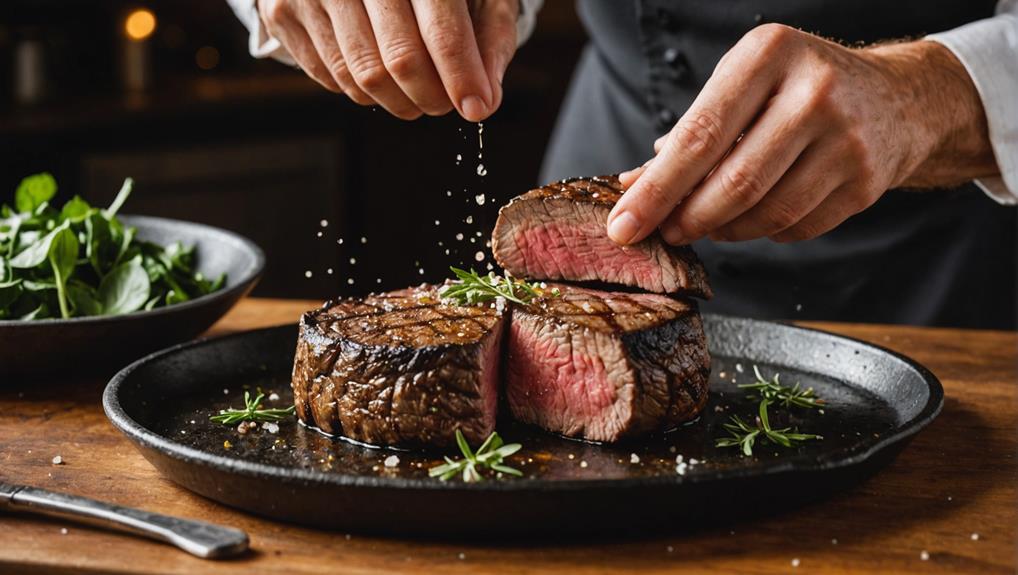
To truly elevate your dish to restaurant quality, mastering the art of finishing touches and searing is essential.
Begin by selecting high-quality fats for searing, such as clarified butter or oils with high smoke points. This ensures even cooking and prevents burning, allowing you to achieve that perfect, flavorful crust through the Maillard reaction. When searing proteins, aim for the right temperature to enhance both taste and visual appeal.
After cooking, allow your meat to rest. This crucial step redistributes juices, resulting in a more tender and flavorful final product.
As you plate your dish, consider adding a finishing touch to take it to the next level. A drizzle of high-quality olive oil can brighten flavors and enhance presentation, while a sprinkle of flaky sea salt adds a satisfying crunch and elevates the overall taste profile.
Don't overlook the power of fresh citrus; a squeeze of lemon or lime can provide a zesty contrast to rich flavors.
Plating Your Sous Vide Creations
After perfecting your sous vide cooking technique, presenting your creation is the final step in achieving a restaurant-quality meal at home. Plating your sous vide dishes isn't just about making food look pretty; it's about elevating your culinary experience.
Start by selecting a clean, contrasting plate that will showcase your delicious food. Arrange components with height and layers to add visual interest and elegance. Remember, you're not just serving a meal; you're creating a work of art.
When plating, consider these key elements:
- Use negative space to create balance and highlight main ingredients
- Drizzle sauces around the plate, not over the food
- Garnish with fresh herbs or edible flowers for color and texture
- Layer components to add depth and dimension
Don't be afraid to experiment with your plating techniques. Try different arrangements and garnishes to find what works best for your dish.
Remember to keep your presentation clean and uncluttered. By focusing on these details, you'll transform your sous vide creations into restaurant-worthy masterpieces.
With practice, you'll develop your own signature plating style, impressing family and friends with your innovative culinary skills.
Frequently Asked Questions
How to Make Home Food Taste Like Restaurant?
To make home food taste like restaurant meals, you'll need to master seasoning techniques, prioritize ingredient quality, and perfect various cooking methods. Experiment with bold flavors, invest in premium tools, and practice plating for a truly innovative culinary experience.
Why Does Restaurant Food Taste Better Than Home Cooked?
You'll find restaurant food tastes better due to advanced cooking techniques, flavor enhancement methods, and superior ingredient quality. They've mastered the art of balancing flavors, using specialized equipment, and sourcing top-notch ingredients to elevate your dining experience.
Why Eating at Home Is Better Than Eating at Restaurant?
You'll save up to 60% by eating at home. With meal prep, you'll unlock cost savings and boost family bonding. You'll innovate in your kitchen, customizing dishes to your tastes and health goals while creating lasting memories.
What Is the Secret of Good Cooking?
You'll unlock culinary greatness by mastering essential cooking techniques, perfecting flavor balance, and prioritizing ingredient quality. Experiment boldly, trust your palate, and don't shy away from innovative flavor combinations. Your kitchen's the stage; make every dish a showstopper.
Final Thoughts
You've mastered the art of sous vide cooking, transforming your kitchen into a gourmet haven. With precise temperature control, expert seasoning, and perfect textures, you're now creating restaurant-quality meals at home. Remember, practice makes perfect, so keep experimenting with different foods and techniques. From juicy steaks to tender vegetables, your sous vide creations will impress family and friends alike. Embrace this culinary method, and you'll elevate your cooking to new heights, bringing professional-level dining to your table every day.

